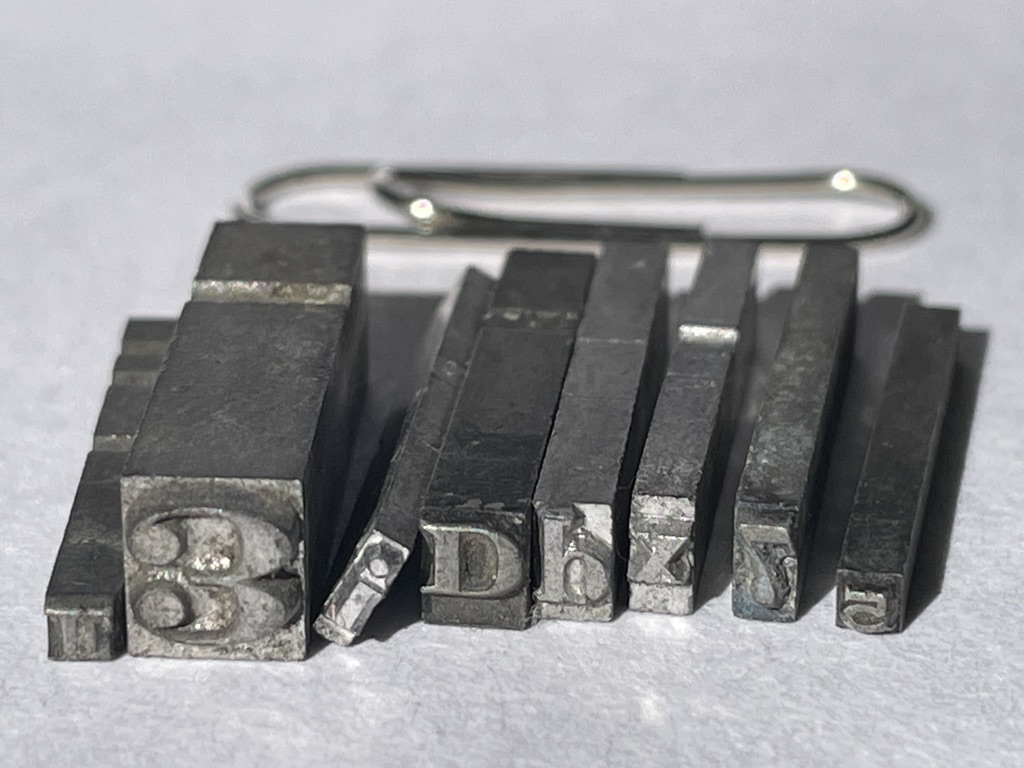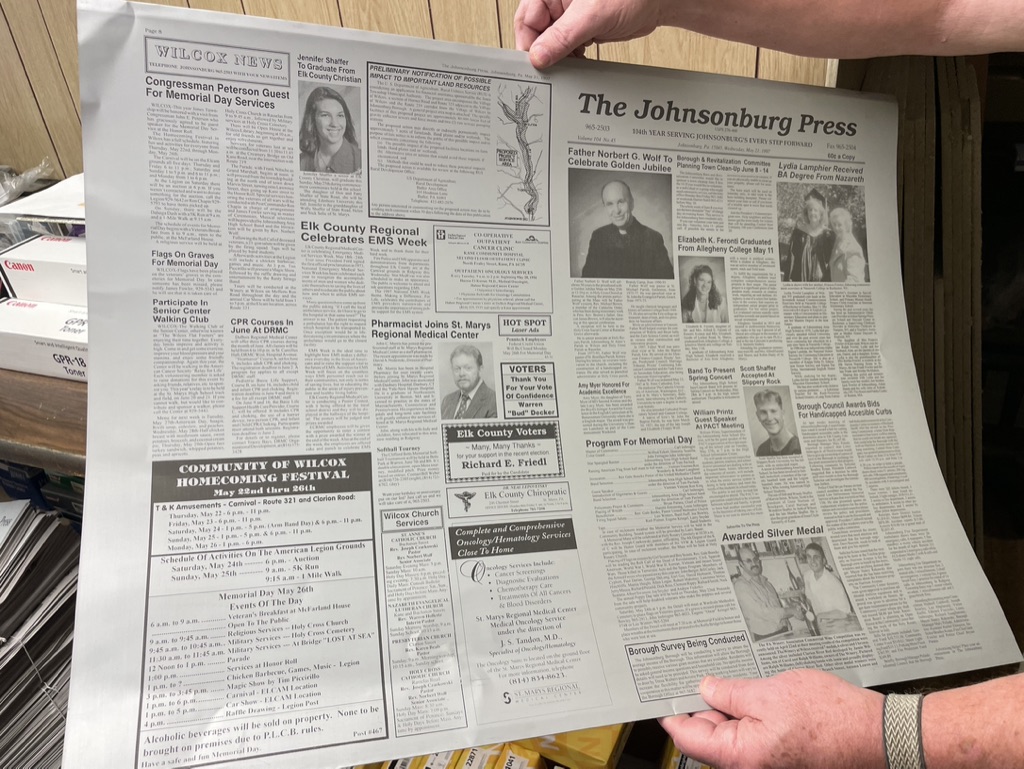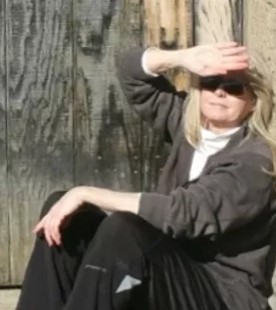The Once-and-Future “Johnsonburg Press”
By Megan Schreiber-Carter
Originally published on the Megan’s Desk blog here
For sale—130-year-old, independent newspaper, in a historic, PA Wilds, Boomtown Borough. Everything is on the table—the name and mailing list; the spacious, 1901 office building and upstairs apartment with nice woodwork; antique-and-recent office machinery and furniture; archived local, regional, national, and world news stories (microfilmed and digitized from 1897 to present day); and, on-site printing contracts for booklets, tickets, membership cards, and the like. (See photos of Megan’s Tour by Floor photos at the bottom of this story on her Megan’s Desk blog.)
This paper, and its predecessors, began when electricity was so new that many didn’t have it, let alone a phone, radio, or car. Only 50 inhabitants here in 1890 led to 3,500 in 1892. That’s the year The New York Times called this booming borough a “thriving young city…favored by nature” because of the rivers winding through it, the timber-forested mountains surrounding it, and the free natural gas piped to all businesses, homes, and streetlamps. In this mountain-valley borough, “paper mills, brick works, tanneries, and lumber mills, interlaced with five lines of railroad” and the sights and sounds of the “rapid creation of hundreds of homes.”*
Under these circumstances, Philadelphia money and its excellent architects built a town remarkably well-crafted from local bricks, stone, and lumber.* Outside newspapers did arrive but with delay and often from far away. Right here, there was lots of area news and a local paper could access telegraph wires for wider-world reports.
The Johnsonburg Press emerged as the dominant newspaper, in the late 1890s, as borough population approached 4,000. The new owner and publisher was locally-raised, recent Oberlin College Journalism graduate Alva H. Gregory. Readers subscribed to his weekly, eight-page broadsheet for $1 per year or a few pennies per copy.
Image: The outside of the Johnsonburg Press along Market Street in Johnsonburg
You might have “heard something about it,” but his paper was where you “read ALL about it”—train schedules; regional employment and business details; local, national and international news and events; performances; science and industry news; food specials; political news; opinions; club meetings; potential remedies for plant, animal and human health concerns; awards, hospitalizations, graduations, weddings, deaths, births, and bean bakes; crimes, trials, and punishments; weather forecasts; improvements; new residents; visitors; fires and floods; legal notices; who’d bagged a buck, turkey, grouse, pheasant, or hooked an impressive brook trout….
At a time when you got your news, weekly, about what was going on around you and in the wider world, what was in the local paper was generally a big deal. And, likely, you personally knew, or knew someone who knew, the owner and publisher “who said so” and said it “on the record.”
The borough’s population hit a height of 5,400 in 1920, before living through an infamous Prohibition Era and on through region-wide decline, partly connected to over-harvesting of now-better-sustained natural resources, such as the forests.* As another example, Elk County, again, has a thriving Elk Herd.
Primarily, the paper has been owned and operated by two families—the Gregorys and the Fowlers. The Gregory’s only, and childless, son, Alva K., modernized to off-site, offset, electronic, metal-plate printing in the late 1970s. He also began archiving the back issues, before bequeathing the business, in the late 1980s, to 20-year employee Mrs. Frances Fowler. She passed the positions of owner and publisher on to her son John “Jack” Fowler, who left his career as an electrician to assume stewardship from his mother in 2000. Mrs. Fowler stayed on until her death, in 2015, at the age of 89, following 50 years with the paper.
Today, Jack runs the weekly with Joyce Maletto, who had just left her work at the local flower shop when Mrs. Fowler asked her to join the staff, 35 years ago, in 1989. The families knew each other well. Joyce says, “My gramma worked here for 40 years, until she was 80, setting type, writing, and billing.” Joyce learned to assemble the paper by physically cutting and pasting it together on countertops, so pictures of it could be transferred to metal plates for the printing.
Image: Lead Type pieces, next to a paperclip to show size
“The days of lead type are gone,” Jack says. “The times have changed, and you have to change with them. I’ve accepted the change because we do everything on the computer.”
Joyce laughs at the idea that she has a “job title.” Among other things, she covers area sports, municipal meetings, borough-history columns, some lay out, phones, walk-ins, and accounts. Among other things, Jack handles some lay out, writes ads, manages additional printing jobs, and distributes printed newspapers to area retailers by 11am on Wednesdays.
“A lot of people don’t read [daily] newspapers but enjoy a weekly,” Jack says. “The print run has dropped off in the last couple of years,” he adds, “because we’ve lost so many of the older people in town.” (The borough’s 2020 census population number is 2,404, Elk County’s is 31,000, and PA’s is 13M.)
Image: Modern, metal, offset-printing plate
Weekly, Jack prints 1,000-1,200, six-page, broadsheet newspapers. Approximately, 30% sell from area retailers, 35% mail to Elk County addresses, and 35% mail to out-of-county addresses. Copies sell for $1 each. Subscriptions average $42.50/year, depending upon the mailing distance. “Postage,” at $375/week, “is a major expense,” Jack says.
He and Joyce, each coincidentally born a twin, are now old friends in their 70s. They’d like to see the paper continue to be published and the history preserved. “I’ve had very few bad days here,” Jack says. He’ll miss it but says “life goes on. I can’t do it alone.” Jack has no children. He’s down a part-time staff person. He’s considering retirement, and Joyce is ready to retire.
Joyce will miss covering the accomplishments of the younger generations. She’s concerned about losing her strong connection to the community. People stop in, she says. Some lived here years ago and are visiting their hometown, some are travelers, some are local people who have some news.
“Maybe five or six a week, guys mostly, just come in, sit for hours, and talk.” She says people still laugh about the story of the imposter who arrived in 1956. He fooled many in the borough who—wined him, dined him, lent him money, and introduced him to their daughters as the man they believed to be famous Notre Dame football star and WWII hero Joe Savoldi. Gone before they were on to him, he was caught when he tried to pull the same game on another town.*
Image: Jack and Joyce in the Lobby Office
In answer to the question, “What makes a newspaper independent?” Jack says, “They answer only to their readers. They don’t have corporate America to answer to and get direction from.”
Joyce says, “Nine out of 10 are happy with what you do. We don’t get political. Some have a different opinion. No AP [Associated Press] stuff. Basically, we’re a hometown paper giving recognition to accomplishments.”
“You never please everyone, right Jack?” she says. Jack nods adding, “We report the truth. What’s in the paper is what we believe to be true and verified.”
The main drawback of a weekly, he says, is the “timeframe. People want instantaneous” information. “We don’t do social media because I’m not a big fan of social media,” which contributes to the “downfall of this country and society.” Both agree that immediacy is overrated. Joyce adds, “People make negative comments, on social media, who wouldn’t say ‘boo’ to your face. It’s easy to go on Facebook and complain.”
The paper has no on-line presence. Jack says people can find the address and phone number from existing listings, as always. He doesn’t see on-line-connected publishing as feasible, saying, “That doesn’t sell newspapers. That’s a free give away. It doesn’t pay the bills…. People aren’t gonna come in and buy it; they just look on-line.” A few years ago, he says, the Valley Voice newspaper, in Sheffield, PA, moved from print to on-line subscriptions, lost all its readers, and closed. “Eighty percent of our readers don’t have a real on-line presence, and young people don’t go on-line, except to social media” and not to newspapers.
He’s aware of the two, borough-based Facebook pages averaging 2,500 members each. Many members are fiercely-loyal, current-and-former residents, from around the world, who support the borough’s impressive, historic-downtown restoration. Some members also read his hardcopy paper.
Image: The back office at “The Johnsonburg Press”
Many in the area now tend to advertise and announce on Facebook, instead of in the newspaper. “Facebook cut into our ad revenue—it’s way down,” Jack says. His faceless Facebook account allows him to read, but he doesn’t post; Joyce posts but from her personal Facebook account.
They will publish the final, weekly issue of The Johnsonburg Press “at the end of April or in early May.” Jack is entertaining offers. The Johnsonburg Press, Inc., is an S corporation in the business of publishing and printing. It is not currently turning a profit. The building’s real-estate taxes are $2,509/year.
Some neighboring papers have joined corporate groups interested in reaching local-newspaper readers. Jack’s never sought a corporate-group deal but doesn’t rule one out. He’d like to find “someone with fresh ideas, who could turn a profit.” He’s willing to consider selling, “holding the building,” consulting with new management, and/or hiring. He could pay new staff $10/hour. A full-time staff in the late 70s was five people. Now, Jack says the weekly really needs three, which includes “one to get advertising.”
One loyal subscriber suggests the paper might continue, with only one or two on staff, by republishing back issues, in order, from the first, weekly edition. In addition to profit concerns about that, Jack hesitates over image-production-quality concerns. “It would be very difficult,” he says, to squeeze the old, 24-inch-wide, broadsheet images into his current, 11-inch-wide format.
What will be lost if The Johnsonburg Press were to be no more? “Oh boy,” says Joyce, “that would be a big loss to the community. What’s gonna happen if there’s no newspaper—you tell me.”
Interested in reading and seeing more?
Check out the full blog post by Megan here, including additional photos from her Tour by Floor tour of The Johnsonburg Press building. You can also read more stories at MegansDesk.net.
*Sources and Background
The New York Times, “A Thriving Young City. Why Johnsonburg, Penn., is Prosperous” [Article, © The New York Times 05/04/1892]
US Department of the Interior, National Park Service, National Register of Historic Places [Johnsonburg Commercial Historic District Registration Form and Report, PA Historical and Museum Commission Certification 9/21/99]
MacDonald, Samuel A. “The Agony of an American Wilderness” [Book, © 2005 Rowman & Littlefield Publishers, Inc.]
The Johnsonburg Press, “A Brief History of The Johnsonburg Press” [Article, © The Johnsonburg Press 05/16/1985]
About the Author:
Megan Schreiber-Carter is a third-generation native of a storied, old borough in the Pennsylvania Wilds’ Allegheny Mountains.
For decades, she lived and worked along the Potomac River, in D.C.. These days, Megan finds more inspiration in the forests of her “native altitude,” in the place her family’s called “home” for more than 100 years. Megan creates award-winning, multi-media content for audiences and clients, worldwide, including—Discovery Networks, National Geographic, universities, publishers, diplomats, and other individuals and organizations. She has recently begun launching a creative, non-fiction series, called “Megan’s Mostly-True Stories,” as well as a blog, all of which you can find on her website, MegansDesk.net.
Related Articles
Mark these 2025 PA Great Outdoors photo contests on your calendar
Read MoreANF snowmobile trails open for the winter season
Read MoreCapture the stars! PA Great Outdoors stargazing photo contest open October-December
Read More







